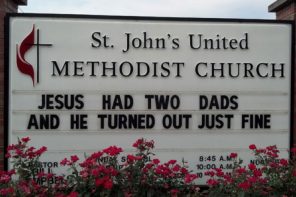University of Chicago theologian Dwight Hopkins once said in an interview that groups at the margins of society possess a medicinal quality for mainstream society.
What does he mean by this? As a Div school student I think immediately of the theology of resistance known in the academy as queer theology, the strand of theological thinking that challenges the ideological and institutional structures that exclude those on the margins of society—particularly those who subvert Western sexual norms.
I believe that one of the norms queer theology should challenge more forcefully is the stereotype of the “beautiful” and healthy body. When we praise only bodies that resemble centerfolds or sports stars, we devalue bodies considered broken, ugly, and diseased. Queer theology can pioneer the way to a healthy perception of these broken, ugly, and diseased bodies; it can help us see them as beautiful, and perhaps even “medicinal,” offering healing for a society rapidly heading toward social, spiritual, and ecological devastation.
More on this in a moment, but first an anecdote.
“She Looks Like She’s Dying”
During my two years as a high school teacher, I witnessed several relationships begin, blossom, and wither. As the young and “cool” teacher, I was often asked for advice. What I noticed was that many students (gay, straight, and bisexual) desired the pretty and popular cheerleader girl or the strong, handsome, athletic boy.
Few, however, desired a girl I’ll call “Natasha,” who, because of a recently acquired illness, was thin, small, and didn’t wear makeup. There was also a boy,“Mark,” who suffered from a chronic illness, was small in stature and had yet to develop a deep voice—a fact he was mocked for by his peers, who called him “fag boy.”
My high school students, as they themselves admitted, were influenced by the media ideal of beauty: women with voluptuous, yet thin bodies, light or fair-skinned, long brown or blond hair, and a face free of scars and acne, with a small nose, full lips, and clear eyes. As one student put it, “that girl looks healthy… she is so hot!” As for the ideal media male, he is tall, muscular, usually white, blue eyes, short hair, clean-shaven, and free of blemishes—healthy-looking.
With these ideals in mind, is it any wonder that my high school students made the choices they did? Perhaps “Natasha” and “Mark” reminded the “healthy-looking” students too much of human fragility at a time when they perceived themselves to be invincible. Or, on a more mundane level, the sick and ugly ones just were not beautiful enough, according to the dominant social ethos, to be around.
Once, when I suggested to one student that he talk to Natasha, he told me, “Mr. B, are you nuts? She looks like she’s dying!”
If Theology is Not for Liberation, It’s Not Theology
Queer theology challenges theology itself to rethink its role in church, the academy, and society. As theologian Marcella Althaus-Reid has written: “…if theology is not for liberation […] and if it is not rooted in our experience and does not become transformative, it is not theology.”
To support transformation, however, requires that we walk the line between, on the one hand, over-glorifying only “beautiful” bodies, and, on the other hand, dismissing the body, desire, and the erotic as unimportant. After all, as Reid reminds us, all authentic theology is radically sexual and erotic—it originates from bodies and is meant for bodies, particularly the broken, oppressed, and ugly bodies that society rejects.
Again, why do my former high school students (a microcosm representing the macrocosm of society) deem unhealthy-looking bodies repulsive? One response is that they are simply too entrenched in the media’s beauty standards. But why are these standards so pervasive? I believe that if we look deeper we find an ideological force that powers these standards, and a way of looking at it: the modern atomistic-mechanistic metaphor.
The market ideologies that we live by seek financial progress at any cost—whether this means eliminating those who are a burden to progress, or destroying the natural world until all resources are extracted. They are driven by a concept of the world and everything in it as fragmented (like atoms) and without value, meaning, or purpose (and so ultimately nihilistic). According to this atomistic-mechanistic metaphor, all things, including humans, are mechanical agents that have no relation with the divine, each other, or the natural world.
The atomistic-mechanistic metaphor underlies a consumer society that measures success through the “objective” lens of profit, and fosters a competitive, individualist, ego-driven human being.
Increasingly in this mechanistic world view, unwanted children, individuals with physical and/or mental anomalies, and the elderly (all “ugly” bodies) represent hardships that must be relegated to society’s periphery. Since, according to the mechanistic worldview, all humans are simple cogs in the machine with no inherent value or purpose, it is morally permissible to euthanize and/or isolate individuals who—by virtue of their physical or mental condition—are deemed unable to contribute to the social economy with the same efficiency as a “regular,” beautiful, and healthy adult.
Human Fragility, Brokenness, and Ugliness: Beauty for our Perilous Times
What can queer theology, understood as a liberative and transformative enterprise, do to confront the atomistic-mechanistic metaphor that disregards all broken, ugly, and diseased bodies as disposable?
The Rev. Jim Mitulski’s “Ezekiel Understands AIDS: AIDS Understands Ezekiel, or Reading the Bible with HIV,” offers insight. His essay is a rich experiment in queer theology, subtly critiquing dominant society’s appreciation and worship of “beautiful” bodies.
In his essay, Rev. Mitulski (himself HIV positive) attempts to read and interpret Ezekiel’s vision about the resurrection of dry bones through the lens of an HIV/AIDS-infected person. In the first sentence of the essay, he states that “The book of Ezekiel is about an exiled community moving from devastation to resurrection; it is the story of a community affected by the HIV reconstructing its future.” This disease has altered the functions of the body. It has perhaps transformed the body from a beautiful, healthy, and autonomous body to a broken, ugly, and dependent body. The pain of this transformation is multifaceted and utterly unbearable to many.
Mitulski argues that:
People with HIV understand what it means to feel ashamed, shut down, and reckless. We understand what it means to be fearful of giving or receiving love. We understand what it means to lose the ability to plan for the future. We understand what it means to lose faith in God, in the community, and in ourselves.
These bodies are in constant pain. Individuals who may have once been considered indispensable in their faith community, at their workplace, at their places of leisure (clubs, bars, etc.), and sometimes even within their families, are now expendable, disposable, and/or peripheral. They are to be kept hidden from the healthy and beautiful bodies. They are a gruesome reminder of a mortality that the young and healthy are prone to deny.
Mitulski continues with his powerful essay: “People with HIV understand what it means to be viewed as expendable. We understand the impermanence of the body and its fragility.” The broken body experiences rejection, ridicule, and shame in a society that prides itself on appearance. It is a body that knows firsthand discrimination at the workplace, at schools, and even at the doctor’s office.
The Greatest Physical Ugliness, The Unspeakable Beauty of God
When considering whether I should bring an HIV-positive guest speaker to my high school, I asked several of the students for their feedback. One girl told me that she liked the idea, but was nervous at the possibility of being in close proximity to an HIV-positive individual. Another student seemed to echo the language of the religious right when he stated that “these people got that infection for a reason… they looked for it.” Even some parents protested the idea. In the end, I didn’t invite the speaker.
Society fears and thus oppresses those bodies outside the social-sexual norm, bodies that reflect poverty, illness, or non-straight sexual identities and desires. Yet, if queer theology—indeed, any theology—is to be effective, it must engage with these bodies. Broken bodies can heal both themselves and other “non-broken” bodies by teaching the power of hope amid personal and social ruin, as well as help many rediscover the beauty and power of relationships based not solely on sex. The sexual desire of beautiful bodies can transform into an erotic desire for friendship, trust, and love.
These “ugly” bodies, however, must first recognize themselves as beautiful bodies. And here is where a theologian might invoke Jesus. Mark D. Jordan, in his book Telling Truths in Church: Scandal, Flesh, and Christian Speech, argues that Jesus’ ugly crucified body is significant not because it was
the greatest physical ugliness, but that we are asked to see through it to the unspeakable beauty of God. The crucifixion inverts our ordinary bodily aesthetic by claiming that the radiant source of all beauty was disclosed to us in a scourged, crucified, dead body.
What an image! Jesus was first healthy and beautiful, then after being scourged and crucified was broken and ugly, and finally, through his ugliness, he once again became beautiful to those who saw in him God’s salvific and liberating presence.
Similarly, those with HIV and other forms of physical and mental difference contain within them the power to save and liberate. They have the ability to transform the world from one that fosters egotism and a mechanistic approach to one that values the organic and multi-erotic relationships among individuals, the divine, and the planet. They embody the hope in a resurrected world where everyone is equal, giving, and loving.
In the words of Mitulski, “God promises to open our graves, and we are called to open our closets, to tell the truth about HIV, to tell the truth about sexuality in all its goodness, to tell the truth about our love.” Ugly, broken, and diseased bodies have plenty to teach healthy and beautiful bodies. Queer theology should serve as a vehicle for broken (but ultimately beautiful) bodies to tell the healing and prophetic truths that our impoverished world so needs to hear.




